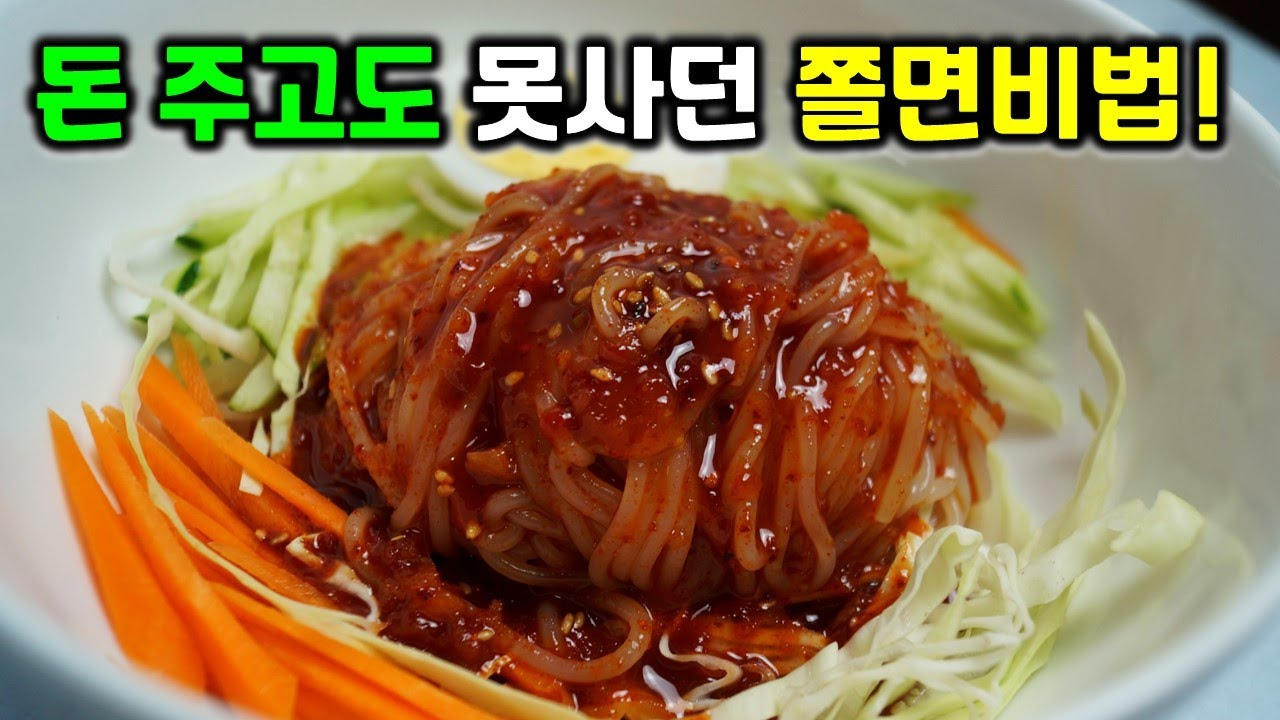Chewy and Tangy Jjolmyeon Noodles
The Ultimate Jjolmyeon Recipe! Make restaurant-quality noodles at home with this golden ratio sauce.

Jjolmyeon, loved for its uniquely chewy and slightly firm texture, is a must-try! This recipe introduces the best jjolmyeon sauce to recreate that deliciousness right in your own kitchen. You can easily make it with common pantry ingredients, and the perfect balance of sweet, sour, and spicy will tantalize your taste buds. Once you try this recipe, you’ll find yourself craving it often!
Main Ingredients- 2-3 servings of Jjolmyeon noodles
- Fresh vegetables (lettuce, perilla leaves, carrots, cabbage, bean sprouts, etc.) – prepared to your liking
Golden Ratio Sauce- 1 Tbsp fine gochugaru (Korean chili flakes, approx. 7g)
- 4 Tbsp sugar (approx. 40g)
- 1/2 Tbsp minced garlic (approx. 10g)
- 2 Tbsp gochujang (Korean chili paste, approx. 60g)
- 2 Tbsp tonkatsu sauce (approx. 20g)
- 4 Tbsp cider or Sprite (approx. 32g)
- 2 Tbsp corn syrup or light corn syrup (approx. 20g)
- Approx. 2g of prepared mustard (about 1 spoonful length)
- 3 Tbsp rice vinegar or distilled vinegar (approx. 24g)
- 1/3 Tbsp toasted sesame seeds (approx. 1g)
- 1 Tbsp fine gochugaru (Korean chili flakes, approx. 7g)
- 4 Tbsp sugar (approx. 40g)
- 1/2 Tbsp minced garlic (approx. 10g)
- 2 Tbsp gochujang (Korean chili paste, approx. 60g)
- 2 Tbsp tonkatsu sauce (approx. 20g)
- 4 Tbsp cider or Sprite (approx. 32g)
- 2 Tbsp corn syrup or light corn syrup (approx. 20g)
- Approx. 2g of prepared mustard (about 1 spoonful length)
- 3 Tbsp rice vinegar or distilled vinegar (approx. 24g)
- 1/3 Tbsp toasted sesame seeds (approx. 1g)
Cooking Instructions
Step 1
The key to delicious jjolmyeon is the sauce! Let’s start by making the perfect sauce. Add 1 tablespoon (approx. 7g) of fine gochugaru. If your chili flakes are coarse, you can lightly grind them in a blender or mortar for a smoother sauce.

Step 2
Add 4 tablespoons (approx. 40g) of sugar for a touch of sweetness. Feel free to adjust the sugar by 1-2 tablespoons to perfectly match your family’s preference.

Step 3
Next, add 1/2 tablespoon (approx. 10g) of finely minced garlic for a burst of flavor.

Step 4
Now, add 2 tablespoons (approx. 60g) of gochujang to create the spicy base. Keep in mind that gochujang can thicken over time, so its density might vary. If it seems too thick, you can always adjust the sweetness and acidity later by adding more sugar or vinegar once the sauce is complete!

Step 5
For a unique depth of flavor, stir in 2 tablespoons (approx. 20g) of tonkatsu sauce. This ingredient adds a special touch! If you don’t have tonkatsu sauce, you can substitute it with 1 tablespoon of vinegar and 1 tablespoon of ketchup.

Step 6
Add 4 tablespoons (approx. 32g) of cider or a similar carbonated lemon-lime beverage for a refreshing sweetness. You can also substitute with orange juice or tangerine juice for a different fruity note.

Step 7
Stir in 2 tablespoons (approx. 20g) of corn syrup for gloss and sweetness. Please note that other sweeteners like ‘Yoridang’ or ‘Oligodang’ may have different sweetness levels, affecting the final taste. It’s best to use corn syrup or adjust sweetness accordingly if using alternatives.

Step 8
For a zesty kick, add about 2g of prepared mustard. This is roughly the amount you’d get from a spoonful length of mustard squeezed out.

Step 9
To prevent the mustard from clumping when added to the sauce, it’s best to mix it with liquid first. Place the mustard in a small cup.

Step 10
Pour 3 tablespoons (approx. 24g) of rice vinegar over the mustard.

Step 11
Whisk the mustard and vinegar together until well combined and smooth. This ensures the mustard is evenly distributed in the sauce for a consistent flavor.

Step 12
Pour this well-mixed mustard-vinegar mixture into the main sauce base. It looks a bit like pineapple juice!

Step 13
Finally, add about 1/3 tablespoon (approx. 1g) of toasted sesame seeds for a nutty aroma.

Step 14
Mix all the sauce ingredients thoroughly until well combined. For the best sesame oil aroma, drizzle about half a tablespoon of sesame oil right before mixing and eating. Adding it too early can cause the fragrance to dissipate.

Step 15
Prepare your vegetables. Chop about 50-60g of your favorite vegetables, such as lettuce, perilla leaves, carrots, cabbage, onions, or boiled bean sprouts.

Step 16
It’s time to cook the jjolmyeon noodles. Boil them in plenty of water. The amount of sauce prepared is roughly enough for 2 servings of jjolmyeon.

Step 17
Some jjolmyeon noodles are designed to separate easily even when cooked in a clump. Many brands are available that you can cook directly without separating them first. Check the product packaging for instructions.

Step 18
Once the noodles are cooked, rinse them under cold running water, rubbing gently for about 2-3 times. This step removes excess starch, resulting in a chewier and more resilient texture.

Step 19
Drain the noodles thoroughly in a colander. It’s crucial to squeeze out as much water as possible to prevent the sauce from becoming diluted and watery.

Step 20
Place the drained jjolmyeon noodles in a serving bowl. Add the prepared vegetables as desired, and generously ladle 6-7 tablespoons of the jjolmyeon sauce over the top.

Step 21
Just before mixing, add about half a tablespoon of sesame oil to enhance the fresh, nutty aroma.

Step 22
Now, mix everything together until well combined! Taste the noodles and if you feel it needs more flavor, add another 1-2 tablespoons of sauce and mix again until it’s perfect for your palate.

Step 23
Your delicious jjolmyeon, with its perfect chewy and firm texture, is ready! Enjoy a flavorful mouthful!




